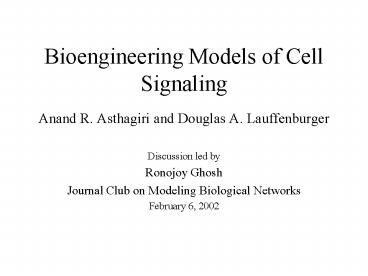Bioengineering Models of Cell Signaling - PowerPoint PPT Presentation
1 / 17
Title:
Bioengineering Models of Cell Signaling
Description:
Bioengineering Models of Cell Signaling. Anand R. Asthagiri ... Example: Xenopus blastula cells, different number of bound receptors, different transcription ... – PowerPoint PPT presentation
Number of Views:134
Avg rating:3.0/5.0
Title: Bioengineering Models of Cell Signaling
1
Bioengineering Models of Cell Signaling
- Anand R. Asthagiri and Douglas A. Lauffenburger
- Discussion led by
- Ronojoy Ghosh
- Journal Club on Modeling Biological Networks
- February 6, 2002
2
Introduction
- Ubiquitous in regulating biological processes
- Development, tissue function, immune response
- Cell signaling
- Read Translate React Write
- Aberrations
- Autoimmune diseases, cancer development
- Target for disease therapy
- Quantitative insight
3
Signal Transduction Mechanism
- Large number of molecules and interaction
- Example read functionality
- ECM extracellular matrix
4
Signal Transduction Mechanism
- Translation cascade (simplified)
- Involves numerous intracellular molecules
- Lipids, proteins
5
Signal Transduction Mechanism
- Different functional domains
- Mediate physical interaction
- Phosphorylation
- Protein docking
- Catalyze reactions
- Lipid cleavage
6
Interconnectivity
- Multiple domains
- Branch points
- Reconvergence further downstream
- Different stimulus-sensor pairs share common
machinery - Multiple stimuli ? interconnected signaling
network ? multiple cell functions
7
Signaling Biochemistry
- Information flow metrics
- Degree of phosphorylation, catalytic activity
- Steady-state efficiency
- Local sensitivity factor
- Global sensitivity
- Hill coefficient, ?
- ? gt 1, ultrasensitive response
8
Signaling Biochemistry
- Other stimulus-response relations
- Biphasic
- Triphasic (three different response states)
- Example Xenopus blastula cells, different number
of bound receptors, different transcription - Stochastic analysis
- Random variations can influence decisions
- Insight transient analysis required
9
Signaling Biochemistry
- Transient signals
- Cyclical and noncyclical
- Adaptation signal returns to base (unstimulated)
steady-state level
10
Signaling Biochemistry
- Noncyclical signals
- Transient change of rate influences downstream
targets in case of complete adaptation - Same time scale E. coli run and tumble
- Delayed action ERK2 activation 15 min affects
DNA synthesis 15 hr later - Integral of pulse-signal is good information
metric
11
Signaling Biochemistry
- Cyclical transient signals
- Oscillations of cytosolic free calcium ions
- Signal frequency changes with agonist through
positive and negative feedback - Frequency encoded cell response information
- Cell cycle related cyclins and cyclin-dependent
kinases - Need mathematical modeling framework for dynamic
analysis
12
Signaling Biophysics
- Spatial differentiation
- Extracellular e.g.. track for immune response
- Intracellular proper localization of proteins
- Extracellular environment
- ECM dynamic space
- Regulated location of extracellular cues
- Viscosity change, scaffolds, blocking molecules
- Active vesicular transport Wingless in
Drosophila - Autocrine cell secreted ligands, system
conditions regulate group of cells receiving
signal
13
Signaling Biophysics
- Intracellular localization
- Membrane localized reactions
- Membrane associated proteins
- Reaction kinetics and diffusion rates determine
localized substrate depletion - Regulates signal transfer rates and components
- Compartmentalization
- Active transport of signaling molecules to
intracellular vesicles GFR-mediated signaling
14
Signaling Biophysics
- Localization changes reaction dynamics
- Local concentrations change Hill coefficient
- Localization could introduce cross-talk
- Signaling fidelity preserved through scaffold
proteins hard-wiring specific pathways - End-point activity localization AKAP
15
Mechanical Forces
- Response to external loads
- Example mechanical resistance of cartilages
- Examples shear stress affects cells lining blood
vessel walls - Mechanoreceptors at cell membrane
- Binds to both ECM proteins and cytoskeleton
- Mechanism
- Geometrical reconfiguration
- Alter reaction kinetics
16
Mechanical Forces
- Mechanism
- Change enzyme functionality
- Physiochemical signaling works both ways
- Chemical signals converted to mechanical force
through cytoskeleton - Local ECM proteins modified
17
Conclusion
- Network modeling hard!!
- Hierarchical design
- Process modules
- Reaction kinetics differential equations
- Higher level
- Boolean or fuzzy logic
- Next example of computational analysis
- Asthagiri AR, Lauffenburger DA. A computational
study of feedback effects on signal dynamics in a
mitogen-activated protein kinase (MAPK) pathway
model. Biotechnol. Prog. 2001, 17, 227-239































